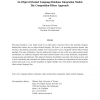Free Online Productivity Tools
i2Speak
i2Symbol
i2OCR
iTex2Img
iWeb2Print
iWeb2Shot
i2Type
iPdf2Split
iPdf2Merge
i2Bopomofo
i2Arabic
i2Style
i2Image
i2PDF
iLatex2Rtf
Sci2ools
134
click to vote
ECOOP
1992
Springer
1992
Springer
An Object-Oriented Language-Database Integration Model: The Composition-Filters Approach
This paper introduces a new model, based on so-called object-composition filters, that uniformly integrates database-like features into an object-oriented language. The focus is on providing persistent dynamic data structures, data sharing, transactions, multiple views and associative access, integrated with the object-oriented paradigm. The main contribution is that the database-like features are part of this new object-oriented model, efore, are uniformly integrated with object-oriented features such as data abstraction, encapsulation, message passing and inheritance. This approach eliminates the problems associated with existing systems such as lack of reusability and extensibility for database operations, the violation of encapsulation, the need to define specific types such as sets, and the incapability to support multiple views. The model is illustrated through the object-oriented language Sina.
Related Content
| Added | 10 Aug 2010 |
| Updated | 10 Aug 2010 |
| Type | Conference |
| Year | 1992 |
| Where | ECOOP |
| Authors | Mehmet Aksit, Lodewijk Bergmans, Sinan Vural |
Comments (0)

